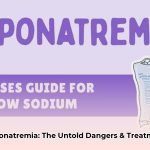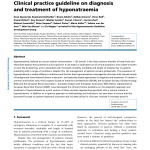Hyponatremia, characterized by low blood sodium, presents a complex clinical challenge. This article synthesizes the latest research and contemporary treatment strategies to provide a clear and actionable guide. We address common pitfalls, compare treatment modalities, and offer a systematic approach to diagnosis and management. Furthermore, we explore emerging trends and share practical insights to optimize patient outcomes in hyponatremia care. This comprehensive overview integrates crucial findings from recent studies, empowering clinicians to deliver superior hyponatremia management.
Journal Articles Illuminate Hyponatremia: Deciphering the Low Sodium Enigma – Exploring Therapeutic Avenues
Hyponatremia, a state of diminished blood sodium levels, can appear daunting. However, a thorough grasp of this condition is vital for improved health management. Analogous to the malfunctioning component of an engine leading to system-wide disruption, imbalanced sodium levels can precipitate significant physiological disturbances. Though clinical guidelines exist, the diversity of available research can complicate treatment decisions. This article elucidates current knowledge, unresolved issues, and ongoing research endeavors. We will examine journal articles on hyponatremia to evaluate the efficacy of current treatment paradigms.
The Sodium Narrative: Evidence-Based Insights – Unveiling the Role of Vaptans and Management of Chronic Hyponatremia
The existing body of literature on hyponatremia is extensive, yet inconsistencies persist. These discrepancies arise from the inherent complexity of hyponatremia and variations in study methodologies. Some studies rely on expert consensus, while others aggregate data from smaller trials. Such heterogeneity can lead to conflicting recommendations, particularly concerning the use of certain medications, such as vaptans, which facilitate water excretion.
Consensus exists on several key principles. A gradual and controlled increase in sodium levels is universally recommended to mitigate the risk of osmotic demyelination syndrome (ODS), a potentially devastating neurological complication. Regular monitoring of serum sodium levels is paramount. Identifying and addressing the underlying cause of hyponatremia, such as dehydration, renal dysfunction, or medication-induced effects, is the initial step in formulating a targeted treatment strategy. Does this lack of consensus regarding the optimal management of chronic low sodium necessitate further investigation?
However, considerable debate remains. The optimal approach to managing chronic hyponatremia is not fully defined. The efficacy of certain pharmacological interventions is a contentious subject. Moreover, limited long-term data exists to substantiate the sustained benefits of these treatments beyond symptomatic relief. The scarcity of longitudinal data stems from the logistical and financial challenges inherent in conducting large-scale, long-term studies.
Navigating the Challenges: Complexity in Diagnosis and Treatment – Understanding Age-Related SIADH and Importance of Fluid Management
Hyponatremia is a significant health concern associated with increased mortality. However, establishing a direct causal link can be challenging. Distinguishing between true hyponatremia and “pseudohyponatremia,” in which other blood constituents falsely lower sodium readings, further complicates diagnosis. Accurate laboratory assessments are essential to avoid misdiagnosis. Older adults with SIADH (syndrome of inappropriate antidiuretic hormone secretion) are at an elevated risk of complications, highlighting the importance of age-specific management strategies. Hyponatremia quantitatively correlates with a higher mortality rate.
Adherence to treatment regimens, particularly those involving strict fluid restriction, can be burdensome for patients. Therefore, the development of more convenient and effective therapeutic alternatives is a priority. The diverse clinical presentations of hyponatremia further complicate the development of universally applicable guidelines.
Future Directions: A Collaborative Strategy – Collaboration Between Clinicians, Researchers, Regulators, and Pharmaceutical Companies
A multifaceted strategy is necessary to enhance hyponatremia treatment. This necessitates collaborative efforts from clinicians, researchers, regulatory bodies, and pharmaceutical entities.
Here’s how different stakeholders can contribute:
| Stakeholder | Objectives (Next Year) | Vision (Next 5 Years) |
|---|---|---|
| Clinicians | Adhere to established guidelines; meticulously monitor serum sodium; implement appropriate diagnostic testing. | Conduct extensive comparative treatment studies; refine hyponatremia diagnostic tools; explore innovative serum sodium monitoring techniques. |
| Researchers | Execute large-scale comparative treatment trials; define optimal sodium correction rates based on age and health status; develop predictive models for ODS. | Devise personalized treatment protocols; conduct thorough investigations into the correlation between hyponatremia and increased mortality. |
| Regulatory Agencies | Evaluate existing guidelines based on current evidence; enhance guideline flexibility. | Promote international guideline harmonization; establish enhanced standards for research reporting and dissemination. |
| Pharmaceutical Companies | Support studies evaluating novel and existing treatments; enhance diagnostic modalities; develop strategies to improve patient adherence. | Invest in the discovery of innovative treatments and technologies; explore advanced formulations of existing treatments. |
The advancement of hyponatremia management is a continuous process. Further research is essential to fully elucidate this complex condition and to create more effective therapies. This requires collaborative clinical trials and a multidisciplinary approach. The ultimate goal is to provide more effective, individualized care, leading to enhanced outcomes and improved quality of life for individuals affected by low sodium levels. What impact will personalized medicine have on future treatment strategies?
Optimizing Adherence to Fluid Restriction in Chronic Hyponatremia – Proven Strategies and Insights
Key Conclusions:
- Current hyponatremia treatment recommendations lack conclusive evidence, leading to inconsistencies.
- Fluid restriction is a primary strategy in managing chronic hyponatremia, but its efficacy varies.
- Optimal treatment demands consideration of the hyponatremia subtype, patient health, and individual variables.
- Notable discrepancies in treatment approaches highlight the need for additional research and consensus-building.
- Enhancing patient adherence to fluid restriction is critical for effective chronic hyponatremia management, requiring a comprehensive approach.
Understanding the Challenges of Hyponatremia Management – Assessing Variability and Effectiveness
Hyponatremia, defined by abnormally low blood sodium concentrations, introduces considerable diagnostic and therapeutic challenges. While beneficial, treatment guidelines often lack definitive answers due to the condition’s diverse subtypes, each with unique pathophysiologies and therapeutic responses. For example, the ideal rate of serum sodium correction remains a subject of debate among experts. How can we reconcile these differing recommendations and enhance treatment outcomes?
The Critical Role of Fluid Management – Identifying Barriers to Compliance
Fluid restriction is often the first-line treatment in chronic hyponatremia. However, achieving and maintaining adherence to these restrictions is a major challenge. Patients may struggle to understand the rationale behind the restrictions or find them difficult to integrate into their daily routines. Consequently, poor adherence can lead to treatment failure and potential health complications. What percentage of hyponatremia patients experience compliance issues?
Strategies to Improve Adherence – Applying Personalized Medicine and Digital Support
Improving patient adherence to fluid restriction requires a multifaceted approach:
- Education: Provide clear, concise explanations of the condition, the importance of fluid restriction, and the risks of non-compliance. Use accessible language and visual aids to enhance comprehension.
- Personalized Plans: Tailor advice to individual needs and lifestyles, considering factors such as diet and activity level. Generic guidelines are often ineffective.
- Behavioral Interventions: Implement goal-setting, self-monitoring, and regular feedback to reinforce positive behaviors. Cognitive-behavioral therapy and motivational interviewing can address psychological barriers to adherence.
- Technology: Utilize mobile apps, wearable sensors, and telehealth platforms to monitor fluid intake and provide ongoing support.
- Support Systems: Involve family and caregivers in the management plan for enhanced support and accountability. Support groups can provide peer-to-peer learning and emotional support.
Addressing Unresolved Issues – Exploring Gender-Specific Treatment and the Role of Organic Osmolytes
Despite advances, several aspects of hyponatremia management remain unclear. Gender-specific differences in treatment response warrant additional investigation. The role of organic osmolytes (substances that help cells maintain cell volume) in brain cell adaptation requires further study. Are we neglecting nuanced factors affecting treatment success?
The Future Path – Collaborative Improvements in Patient Outcomes
Improving hyponatremia treatment demands collaborative efforts. Clinicians must tailor treatment plans to address individual patient needs and preferences. Researchers must investigate unresolved questions to provide a stronger evidence base for future guidelines. Joint efforts among clinicians, researchers, and patients are crucial for optimizing care. Only through a comprehensive approach can we effectively manage the challenges of hyponatremia. Can AI-driven diagnostic tools improve patient outcomes?
https://pubmed.ncbi.nlm.nih.gov/17666349/
Effective Hyponatremia Management Strategies in Geriatric Patients – Special Considerations
- Wellness Fair Ideas for Work to Boost Employee Wellbeing - December 15, 2025
- Affordable Employee Wellness Fair Ideas for Any Budget - December 14, 2025
- Employee Wellness Programs Strategically Benefit Employee Health And Retention - December 13, 2025















